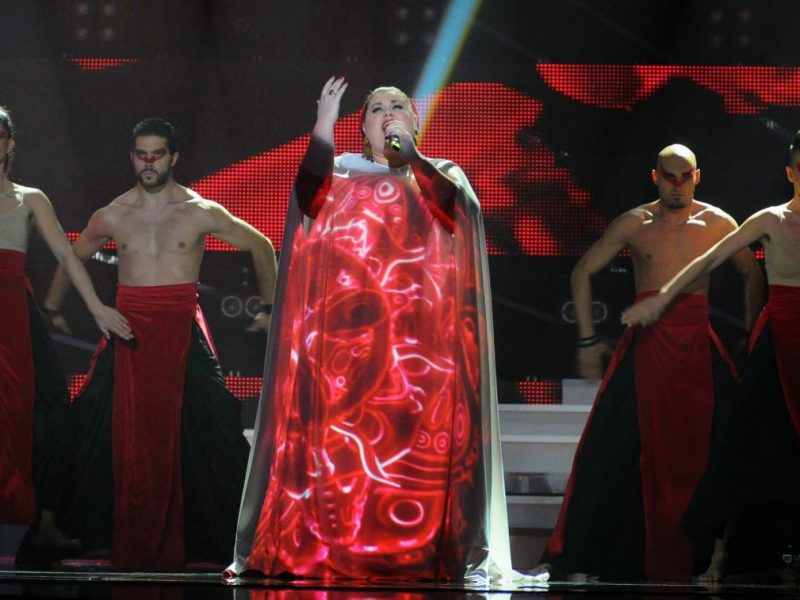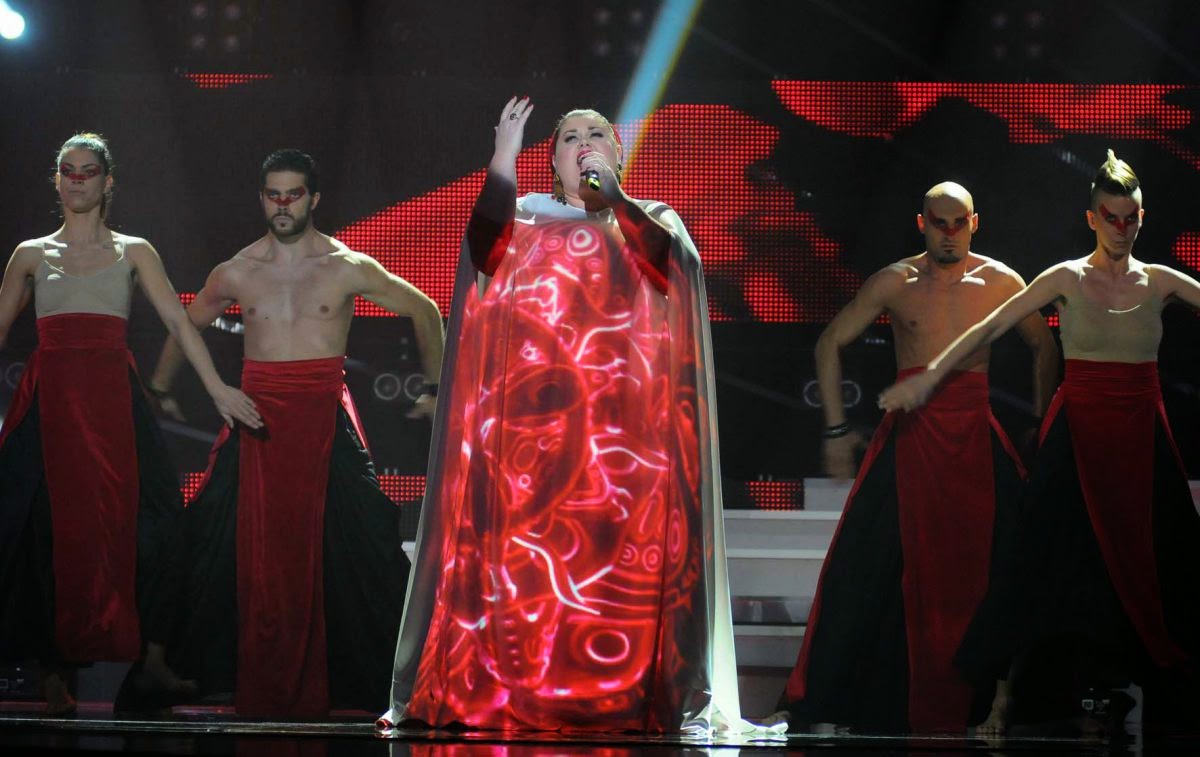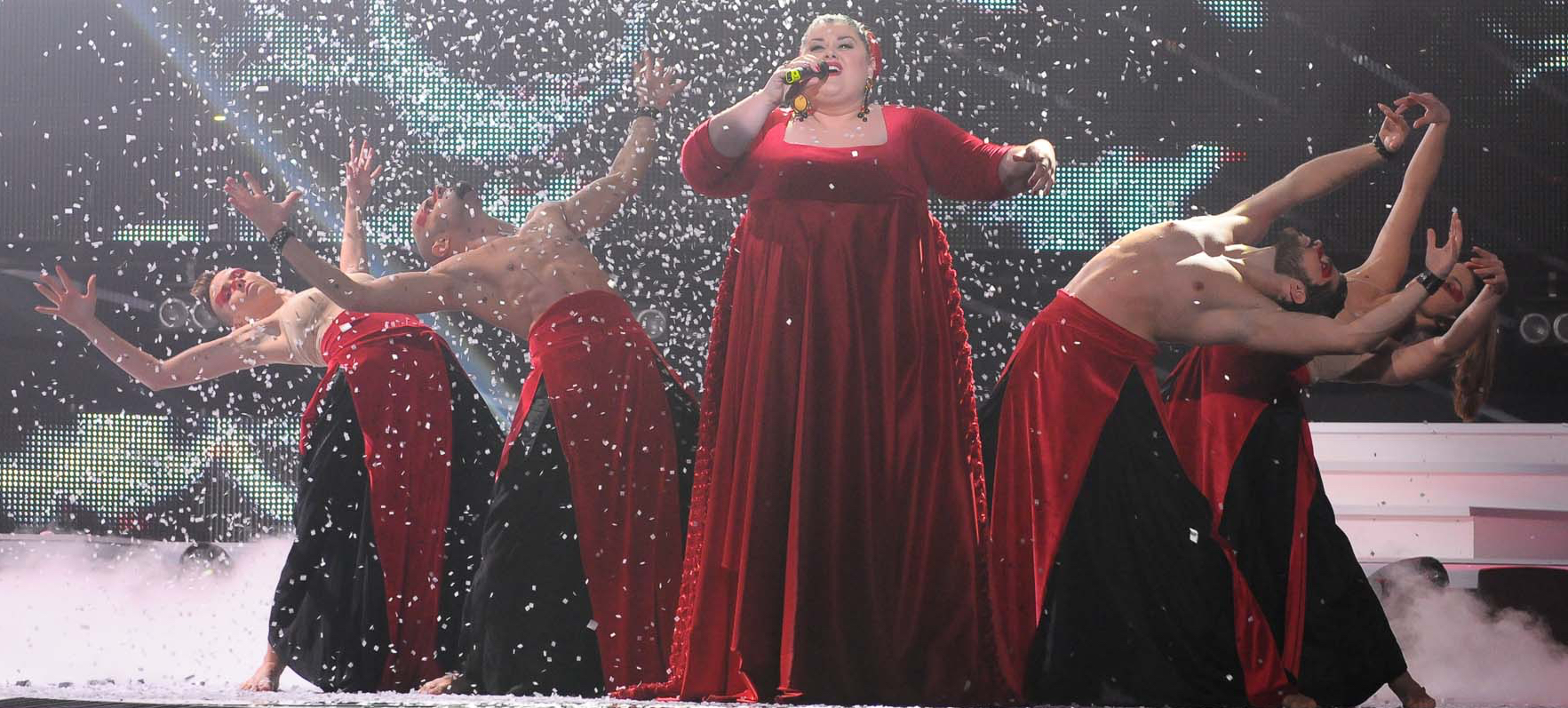
6 Photos
Queer as Turbofolk Part VII’s second installment of gender and performance examines the sexuality of so-called ‘older women’ and drag. Read part one of gender and performance for more.
“Estrada opposes the social order that by definition puts the taboo on the sexuality of older women,” writes Olga Dimitrijevic – summing up one of the things I find most refreshing about the genre. It’s not uncommon for singers in their 50s and 60s, often those whose careers began as Yugoslav folk and ballad singers in the 1970s and 1980s but who have since transitioned to pop-folk, to be presented in sexualized contexts and as disco divas, something practically unthinkable in Anglo-American pop music with the exception of Madonna. We can see this in the then 54-year-old Yugoslav icon Lepa Brena’s 2014 TV performance of synthtastic club banger Uradi to, which even features a strip.
In the uplifting, Dejan Milićević-directed video for 2012’s Nije dobro (Girl’s Night) , 61-year-old Neda Ukraden (another Yugoslav icon to have switched from folk to floorfillers) dons a silver catsuit and hits the dancefloor with Slovenian duo Clea & Kim. The theme of the song and video is women supporting each other and sticking together, with Neda portrayed as part maternal figure, part older sister to the younger duo. As Rory Archer states in Assessing Turbofolk Controversies: Popular Music between the Nation and the Balkans, “females [in turbofolk are] attributed with agency through tropes of hot blood, a sense of fun, and female camaraderie.” Dijana Jelača concurs, observing that “female agency and camaraderie seem to be popular motifs in turbo folk.”
https://www.youtube.com/watch?v=raDH-CiSXUY
“[The] paradox of estrada bodies lies in the fact that they can also act as a ‘crack’ in the smooth nationalist discourse based on patriarchy,” argues Marijana Mitrović in 2011 paper The ‘Unbearable Lightness’ (of the Subversion) of Nationalism: Bodies on Estrada in Postsocialist Serbia. “According to Zarana Papić, the key element in the construction of Serbian nationalism was the reinforcement of patriarchal polarization of gender roles and their ‘naturalization.’ Hence is it not surprising that gay and lesbian activist groups accept neofolk and its potential to act subversively with regard to patriarchal moral. For example, this potential is reflected in modifications of the ‘natural’ body and open sexualization of the body of middle-aged (even elderly) women. This rocks the foundations of a symbolic order which makes a taboo out of any manifestations of sexuality of women who are ‘past their prime’. At the same time it questions the ‘naturalness’ of the body and predetermination of gender identities.”
Plus-sized Macedonian drag queen Boki 13 (Bojan Jovanovski) definitely throws a spanner in the works of predetermined gender identities. In the video for 2009’s Otvori se (“Open Yourself Up”), the performer can be seen wearing everything from an Yves Saint Laurent dress and blue lipstick to Mickey Mouse ears and a cockerel-shaped hat. During the trumpet breakdown in the middle-eight, in a striking scene undoubtedly designed to court controversy, Boki 13 appears in blackface, red lipstick and an afro wig while whipping an attractive young white man. The song’s folksiness and strong Balkan sound makes the accompanying visual content even more shocking. The lyrics follow a theme of what Jelača calls “feminine libidinal entrepreneurship” – Boki 13 (who I understand uses male pronouns) positions himself as a sponzoruša looking for a rich man to “put his credit card on the table”, buy him “real Louis Vuitton” and take him to his yacht. Same.
“The next step in destabilization of gender as an ‘original’ that is constantly (unsuccessfully) carried out and at the same time imitated and mocked is drag performance,” continues Marijana Mitrović. “Drag as a figure of a man dressed as a [female]estrada star hits the very symbolic nuclear reactor of nationalism – homophobia. Only a few years ago, [drag queens] were no more than extras in music videos (for instance, [Slatka mala] by Jelena Karleuša), whereas now they appear as independent actors on estrada (Boki 13). A drag is subversive precisely because of over-identification with patriarchal ideals of femininity. It offers excess, a plenitude of enjoyment – but enjoyment in a masculinist ‘uneasiness in culture’, a hyperbolic, inadequate answer to the demands of patriarchy. Stars of estrada become gay icons, and some of them surpass the Serbian public horizon of expectations by openly supporting the fight for gay rights. The most notable example is Jelena Karleuša’s column written in October 2010, when she expressed her support to the Pride Parade and attacked its opponents using excessive, lascivious language, unbecoming to a lady and at the same time, very convincing argumentation, unbecoming to a ‘folk singer’. All of these processes overcome the dimension defined by what I previously called Orthodox minimalism. Their subversiveness in relation to Serbian-Orthodox-nationalist discourse lies in reassessing the hegemony of masculinity, or rather the limits it imposes. If certain aspects of a female singer’s body overcome the limits of masculinist imagination, in a sense that the body has been shaped in accordance with such imagination, but transcends its limits, if the body communicates with [a] gay audience and makes it visible, then it additionally undermines the hegemony of masculinity (cf. Dimitrijević 2009).”
We’ve met singer and professional dancer Aleksa Jelić before in Queer As Turbofolk, but not explored his drag work featured on primetime entertainment show “Tvoje lice zvuči poznato”, the Serbian adaptation of Spanish reality format Your Face Sounds Familiar. Some of Aleksa’s performances, like his showstopping six-minute rendition of Beyonce’s Single Ladies, have sadly been removed from Youtube due to rights issues. Others, like his take on Madonna’s Vogue, during which he interacts provocatively with compromisingly-dressed male dancers, remain.
Notably, Jelić also performed in drag as Ceca – a perfect illustration of, in the words of Olga Dimitrijević, “how [the] urban gay community sees [the] female singer’s body as suitable for camp and ironic appropriation, and how this same body can perform a subversive role in regards with Serbian nationalism.”
“Drag becomes the ultimate example of gender’s performativity, of instability of gender roles,” writes Dimitrijević further. “Drag is the parody of stable identities; and in a parodic manner it mocks them. The drag show […] is the deconstruction of essential identities. [The] performed femininity of the female folk singers, as Branislav Dimitrijević says, ‘[presses] open cracks in the patriarchal social order.’ ‘Drag constitutes the mundane way in which genders are appropriated, theatricalized, worn, and done; it implies that all gendering is a kind of impersonation and approximation. If this is true, it seems, there is no original or primary gender that drag imitates, but gender is a kind of imitation for which there is no original; in fact, it is a kind of imitation that produces [the] very notion of the original as an effect and consequence of the imitation itself.’ If gender is not original, natural, then the role of women as the bearer of national identity in nationalism becomes (visible?) as a pure construction, and as the outcome we are faced with a completely opposite reading of Estrada’s female body: it here appears as a reminder of a failure of Serbian nationalism.”
“Estrada opposes the social order that by definition puts the taboo on the sexuality of older women,” writes Olga Dimitrijevic – summing up one of the things I find most refreshing about the genre. It’s not uncommon for singers in their 50s and 60s, often those whose careers began as Yugoslav folk and ballad singers in the 1970s and 1980s but who have since transitioned to pop-folk, to be presented in sexualized contexts and as disco divas, something practically unthinkable in Anglo-American pop music with the exception of Madonna.
Bojana Stamenov ’s Ceo svet je moj (“The Whole World Is Mine”), performed in English at Eurovision as Beauty Never Lies, also explicitly serves to undermine normative beauty ideals and oppressive patriarchal expectations of femininity. The lyrics, penned by Rise Like A Phoenix lyricist Charlie Mason, characterize the larger-figured Bojana as a “dazzling girl” living in a “shadowy world” (Serbia). The entry begins as a typically graceful and austere Balkan Eurovision ballad before composer Vladimir Graić pulls the rug out from under us halfway through, when a dance beat kicks in and the song triumphantly transforms into an uptempo stomper. As Bojana sings “Finally I can say, yes, I’m different and it’s okay – here I am, here I am!”, the backing dancers cast off their white masks and cloaks to reveal diverse outfits (including a rainbow dress), while jazz singer Bojana’s vocals become unrestrained and improvised. It’s a powerful audiovisual depiction of coming out. The lyric “I’m different and it’s okay”, which Bojana repeats again at the climax, is the song’s take-home message – one which resonated with countless viewers, including A-list British comedian Jack Whitehall, who tweeted “Beauty Never Lies from Serbia is not only the best Eurovision song ever, it may be the greatest song ever.” The entry is also notable in being Serbia’s first-ever English-language Eurovision performance.
The original Serbian staging interprets the same theme in a different way, opening with Bojana dressed in a white veil with images literally being projected onto her, just as society’s expectations are. When the dance breakdown erupts and the song loses all pretense of restraint, Bojana’s veil of shame is torn off by her bare-chested male dancers and the true, free Bojana emerges, unhindered by convention or expectation. The staging cribs heavily from camp europop classics like Hera Björk’s Someday and Gisela’s Tu voz se apagara, both almost certainly known to composer Vladimir Graić (a long-time Eurovision follower who separated from his wife of 15 years in 2011 and whose orientation I’ll leave you to speculate on based on this short backstage clip). It’s Graić’s three-minute personal love letter to Eurovision, one that reflects both his own story and Bojana’s, and I love it – the way the songs morphs from a stereotypical “Balkan ballad” into euphoric eurodance is a visceral musical metaphor for shaking oneself free from the shackles of conservatism.
“Latent value judgments, premised on normative gender roles and class-based hierarchies, present a stubborn subtext in the criticism of the sponzoruša and of turbo folk – judgments which perpetually reaffirm class-prejudiced notions of culture proper, and of traditional womanhood, whose embodiment of femininity should be seamlessly natural rather than visibly enacted or technologically-enhanced,” states Dijana Jelača. “Sponzorušas and the accompanying techno-gender of turbo folk [can be viewed] as fields of potential transformation. They become vehicles that might, even temporarily, incite a breakdown of the patriarchal domination that naturalizes and de-historicizes womanhood.”
Jelača highlights “the potentially emancipatory politics of feminine libidinal entrepreneurship as a central theme in turbo folk’s ethos and aesthetics,” and impels those dismissive of the genre or who consider it intrinsically anti-feminist to “consider the affective appeal that turbo folk’s promise of upward mobility might have for a female audience living under precarious circumstances.” She sees “turbo folk’s lasting popular appeal as potentially rooted in the promise of upward mobility that might, albeit temporarily, reposition its female audience away from precarity and a lack of social power,” citing the commodity fetishism of songs like Dragana Mirković’s Red Ferrari, Tina Ivanović’s Cabrio Porsche and Bunda od nerca (“Mink Coat”), and Viki Miljković’s infamous Koka kola, Marlboro, Suzuki (Nikom nije lepše nego nama).
Songs like these articulate what Jelača describes as “an overt and unapologetic erotic investment in material prosperity, often at the expense of love.” She smartly deduces that Ceca’s enduring popularity likely has much less to do with nationalism than it does with “her ability to offer a feminine upward mobility script, which her female fans persistently try to emulate.”
“Certain performances of techno-gender, or hyper-feminine drag, make possible a temporary dismantling of rigid but permeable boundaries within post-socialist patriarchal structures that bind them,” continues Jelača. “Turbo folk’s sponzorušas – as figures that overtly perform threatening and contradictory cyborg-goddess womanhood and manipulative sexuality – are potentially transgressive figures precisely because they are women who challenge the traditional models of patriarchal relations premised on love plots and naturalized identities. Instead, their enactment of technologically-enhanced femininity is deployed towards fetishizing material security and social power. While the sponzoruša is a figure whose emergence is precipitated by the complexities of post-socialist economic precarity, she is often made into a figurative straw (wo)man upon whom a gender-disciplining moral panic is imposed.“
Jelača bemoans how “the guardians of culture-proper […]dismiss turbo folk and sponzorušas as merely immoral and culturally base. This view also sees turbo folk’s (numerous) female fans as morally lacking, instead of exploring how mediated (‘low’) popular culture might create spaces where women can address, or overtly acknowledge, the gendered aspects of social precarity through performances of hybrid-femininity aimed at gaining material security.” Her conclusion: “far from being a one-dimensional materialistically-driven, patriarchally-defined figure, turbo folk’s sponzoruša enacts commodity fetishism as a form of oppositional activity that undoes the primacy of love plots when it comes to normative modes of femininity. Instead, she inserts herself as a social actor determined to proactively address the conditions of precarity that surround her, by deploying her libido as a tool for upward mobility. In her technological exaggeration of femininity that is overtly manufactured, the sponzoruša makes strange, threatening, and uninviting that which is typically used as a mechanism for making women familiar and vulnerable. From this we can infer that there are valences of gender performativity along feminine lines that have a potential for disrupting inequality by making that which is typically considered organic, transcendent, and natural into something strange and technologically manufactured.”
“It is also important to note the class-based disposition within which the sponzoruša becomes recognized as a social actor so that she can be used as a figure of shame for self-respecting womanhood. When a woman actively deploys the very features of her sexual difference towards achieving socio-economic power (and not just personal empowerment), she creates a slippage that marks libido as class-produced, contextual, and manipulable rather than ephemeral and transhistorical (or, rooted in the sole desire for love in women). This slippage is subsequently disciplined with a moral panic that conceals the phenomenon’s more transgressive aspects. What gets lost in the disciplinary simplification is any consideration of how post-socialist economic precarity – a factual inability to make life into something more than a series of failed hopes, particularly for women – necessitates a utilization of libidinal investments towards turning things around on one’s own terms, and within the limited sets of choices one has available to them. Once her social script becomes culturally widespread via the popularity of turbo folk, the figure of the sponzoruša becomes a performative function deployed by many young women in their refashioning of social mobility. With this, a reconfiguration of the intimate public sphere takes place and stems directly from the precarious circumstances of post-socialist material depravity that limits women’s prospects otherwise. […] Dismissed as an embodiment of materialist patriarchy via her perceived submissiveness to a powerful man, a sponzoruša is often anything but; if submissiveness is a part of her performance, it is typically deployed towards the goal of gaining social power in her own right. Perhaps she is threatening to patriarchy precisely because the sponzoruša bursts the bubble within which feminine libido is normatively directed towards love plots and maternal impulses.”
Until next time.
Get more Queer as Turbofolk here:
Queer as Turbofolk (Part I): “Eastern Europe is Homophobic”
Queer as Turbofolk (Part II): Body Politics
Queer as Turbofolk (Part III): Academic Voices
Queer as Turbofolk (Part IV): Beef Platter






